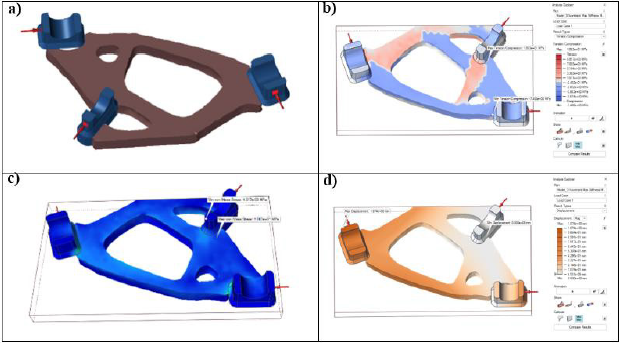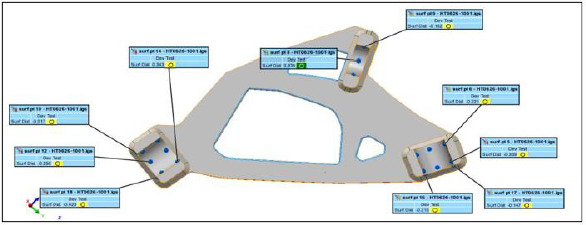- Submissions

Full Text
Aspects in Mining & Mineral Science
Topology Optimization and Additive Manufacturing Application for Check Form Tool on Aviation Industry
Serdar Yurduseven1, Mustafa Özgür Bora2* and Burak Abacı1
1Turkish Aerospace Industries, Turkey
2Aviation Material Research and Development Laboratory, Faculty of Aeronautics and Astronautics, Kocaeli University, Turkey
*Corresponding author: Mustafa Özgür Bora, Aviation Material Research and Development Laboratory, Faculty of Aeronautics and Astronautics, Kocaeli University, Kocaeli, Turkey
Submission: October 07, 2021;Published: October 14, 2021

ISSN 2578-0255Volume7 Issue4
Abstract
Topology optimization is a technique widely used in making a design to have a lighter structure providing the same functionality. With topology optimization, it is possible to design a product much lighter with the same strength values. However, structures having a complicated geometric design cannot be produced by conventional manufacturing methods. To eliminate this limitation, additive manufacturing methods, which are widely used in today’s technology, are used in producing the structures with complicated geometric designs. These structures that prosses a complicated design can be produced with only one processing stage in a short period of time. It is aimed to produce the required product in aviation industry quickly, cheaply, and lightly. In this research, it is aimed to produce a Ø32mm and 2mm wall thick AMS 5566 steel tube to be used in the aviation industry by using the additive manufacturing method in the design of the form control tool by using topology optimization. Thus, it is made possible to produce the form control tool quicker, cheaper, and lighter [1]. With the FDM (Fused Deposition Modelling) method, one of the additive manufacturing methods, the form control set is produced with 60% occupancy and 3 rows on the front of the walls. Polylactic Acid (PLA) polymer is used as the production material. The controls that this polymer used was produced within the desired tolerance values after production were also carried out by laser scanning method. According to the results of measurement, the maximum manufacturing mistakes of PLA material are determined as 0,517mm. As a result of the topology optimization, additive manufacturing, and measurement outcomes, it has been decided to use the form control tool in the controls of a steel tube to be used in the aviation industry.
Keywords: Topology optimization; 3D printer; Check form; FDM; Tool
Introduction
Light product designs and rapid manufacturing methods have gained quite importance with the improving technologies used in aviation industry. In term of these needs, it has become a need to produce the airplane parts quickly, cheaply, and lightly. The topology optimization which is used in the design processes of products made it possible for the product to match the need and be light. Topology optimization explains how the elements or factors should be attached together ideally [2]. Topology optimization can also be defined as optimizing the material distribution in order to reach the ideal structure, provided that it meets the desired conditions in the design [3]. For topology optimization, a design area should be created and the regions that should be excluded from the design are identified by determining the regions that have the least effect on the strength or natural frequency of the structure. Optimized designs created by removing the regions that are not required in the design with topology optimization are very difficult to produce with conventional manufacturing methods. Thus, the designs that are difficult to produce with conventional manufacturing methods can be produced easily and rapidly with additive manufacturing methods [4]. In the study, a design had been created for the check form tool. That design is allowed to have maximum strength as a result of optimization and a volumetric discharge limit of 70%. As a result of the optimization analyze, the tool has been reduced by 28% compared to the conventional design weight. The optimized part was produced with FDM additive manufacturing method and a deviation of 0.517mm that occurred in the tool depending on the measurement results. Since the tube profile tolerances is 1.5mm, the manufactured tube check form tool can be used for the production of aircraft parts.
Optimization Process of Check Form Tool
In this research, the endurance of a tool required for form control of a tube which will be used in aviation industry is maximized with the Altair Inspire program. In addition, it was desired to make a minimum 70% volume optimization for the area selected as the design area [5]. In the (Figure 1), conventional design, will-be optimized design area, and optimized models can be seen. Structural constraints are the main inputs of the optimization process for the design space specified structure. Boundary conditions are given for obtaining the analysis results. Boundary conditions are demonstrated in the Figure 2. The material to be used in the analysis is given as PLA. After determining the boundary conditions, the optimized model have been acquired by selecting the maximum endurance and 70% volumetric discharging terms. In the (Figures 3a & 3b), the optimized model and the structures endurance under the boundary conditions have been demonstrated. In the results of the analysis, the maximum stress value is seen as 10MPa (Figure 3c). Additionally, it has been determined that the maximum displacement value on the structure is 1.07mm (Figure 3d). The results of the part that has been produced by additive manufacturing as a result of the optical measurements are shown in Figure 4. According to these results maximum divergence has been observed as 0,517mm. Since this value is below the profile tolerance of the tube, which is 1.5mm, it is considered to be suitable for the tool and accepted as a feasible tool for form control tool. In the (Figure 5), the bended steel tube is checked on the tool which is manufactured with additive manufacturing method.
Figure 1: Optimization process of check form tool, a) conventional design, b) design space model, c) optimized model.

Figure 2: View of design space and tool boundary conditions.

Figure 3: Results of Topology optimization analysis a) optimized tool design, b) result of Von-Mises Stress, c) results of compression and tension, d) result of displacement.

Figure 4: Optical measurement results of check form tool.

Figure 5: Manufactured check form tool and the steel tube.

Results
The goal is to transform a design projected by conventional methods into the optimum design geometry by using topology optimization method. Besides, it is aimed to lighten the form control tool. In this study, using the FLD additive manufacturing method, the design and production of the tool to be used for AMS 5566 steel tube bending controls from PLA material was carried out with topology optimization. By defining the purpose of the model in which the design area was created, forces were applied to certain regions to prevent the tool from breaking. The tool that has been optimized for certain purposes has been observed to be a 28% lighter. It is thought that the production of the optimized design method with conventional methods is not very convenient in terms of both time and processing. For this reason, it is made possible to produce without any drawbacks by FDM additive manufacturing method. The measurements of the produced form control tool have been carried out, it has been determined that there was a deviation in the profile tolerance of 0.517mm, and since the tube remained within the form tolerance, it was accepted for the use of the form control tool.
Acknowledgments
The support provided by Turkish aerospace Industry (TUSAŞ) is greatly acknowledged.
References
- Zhu JH, Zhang WH, Xia L (2016) Topology optimization in aircraft and aerospace structures design. Arch Comput Methods Eng 23: 595-622.
- Christensen P, Anders K (2008) An introduction to structural optimization. Springer, Germany.
- Brandon WC (2020) Additive manufacturing applications and implementation in aerospace. Master Thesis, MIT, Master of Science in Mechanical Engineering, Massachusetts, USA.
- Grzegorz M, Emiel VDV, Matthijs L, Hubert G, Fred VK, et al. (2021) Topology optimizastion for additive manufacturing with distortion constraints. Comput Methods in App Mech and Engrg 386: 114095.
- Akin D, Istemihan G, Oguzhan Y (2021) Design and additive manufacturing of a fatigue-critical aerospace part using topology optimization and L-PBF process. Procedia Manufacturing 54: 238-243.
© 2021 Mustafa Özgür Bora. This is an open access article distributed under the terms of the Creative Commons Attribution License , which permits unrestricted use, distribution, and build upon your work non-commercially.
 a Creative Commons Attribution 4.0 International License. Based on a work at www.crimsonpublishers.com.
Best viewed in
a Creative Commons Attribution 4.0 International License. Based on a work at www.crimsonpublishers.com.
Best viewed in 







.jpg)






























 Editorial Board Registrations
Editorial Board Registrations Submit your Article
Submit your Article Refer a Friend
Refer a Friend Advertise With Us
Advertise With Us
.jpg)






.jpg)














.bmp)
.jpg)
.png)
.jpg)










.jpg)






.png)

.png)



.png)






